Origin and Significance of Hanuman Vadvanal Stotra
The Hanuman Vadvanal Stotra originates from Bibhishana, Ravana’s brother, who composed it to praise Hanuman’s divine virtues and seek his blessings. This sacred hymn is significant as it is believed to be the first stotra dedicated to Hanuman on Earth, highlighting his immense power and devotion to Lord Rama. It is widely revered for its ability to grant spiritual strength, protection, and relief from adversities, making it a cornerstone in Hindu devotional practices.
1.1. Authorship and Historical Context
The Hanuman Vadvanal Stotra is attributed to Bibhishana, Ravana’s brother, who composed it after seeking refuge in Hanuman. It is considered the first stotra dedicated to Hanuman on Earth, crafted to praise his divine virtues and request blessings. Bibhishana, like Hanuman, is believed to be immortal, and his composition reflects deep devotion and admiration for Hanuman’s unparalleled strength and loyalty to Lord Rama. This stotra holds historical significance as a unique tribute to Hanuman’s divine attributes and his role as a protector and remover of adversities.
1.2. Importance in Hindu Devotional Practices
The Hanuman Vadvanal Stotra holds immense significance in Hindu devotional practices, being chanted to invoke Hanuman’s divine blessings for protection, strength, and relief from adversities. It is often recited during religious rituals, festivals, and personal worship to seek Hanuman’s intervention in overcoming obstacles. Devotees believe that reciting this stotra brings peace, prosperity, and spiritual growth. It is particularly valued for its ability to alleviate suffering and grant courage, making it a cherished part of Hindu spiritual practices and a powerful tool for connecting with Hanuman’s divine energy.

Benefits of Reciting Hanuman Vadvanal Stotra
Reciting the Hanuman Vadvanal Stotra brings spiritual strength, protection, and peace. It alleviates diseases, removes obstacles, and grants prosperity, fulfilling heartfelt desires.
2.1. Spiritual and Mental Well-being
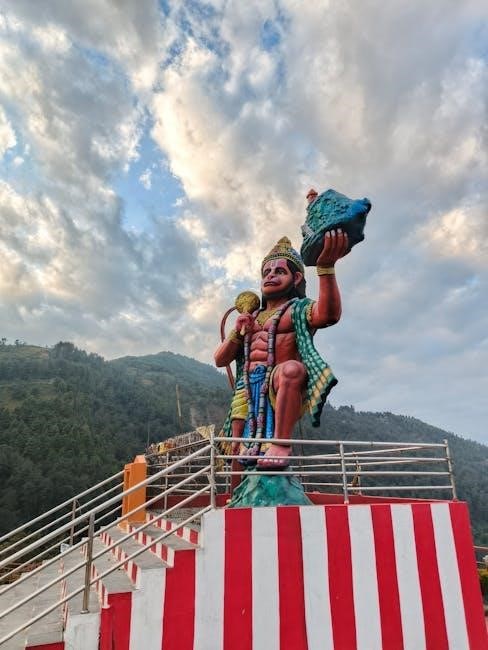
Reciting the Hanuman Vadvanal Stotra fosters spiritual growth and mental tranquility. It helps devotees attain focus, clarity, and inner peace, reducing stress and anxiety. The stotra is believed to purify the mind, enhance devotion, and grant emotional balance. By reciting it with faith, one can cultivate a positive mindset and connect deeply with the divine energy of Hanuman. Regular chanting also strengthens willpower and resilience, enabling individuals to face life’s challenges with courage and confidence.
2.2. Relief from Diseases and Obstacles
The Hanuman Vadvanal Stotra is renowned for its healing properties and ability to alleviate suffering. It is believed to provide relief from chronic diseases, mental afflictions, and physical discomfort. Reciting this stotra is thought to remove obstacles in life, offering protection against negative energies and misfortunes. Devotees often chant it to seek Hanuman’s divine intervention for health issues and to overcome challenging circumstances. Its verses are considered powerful tools for restoring well-being and ensuring a smooth journey through life’s trials.
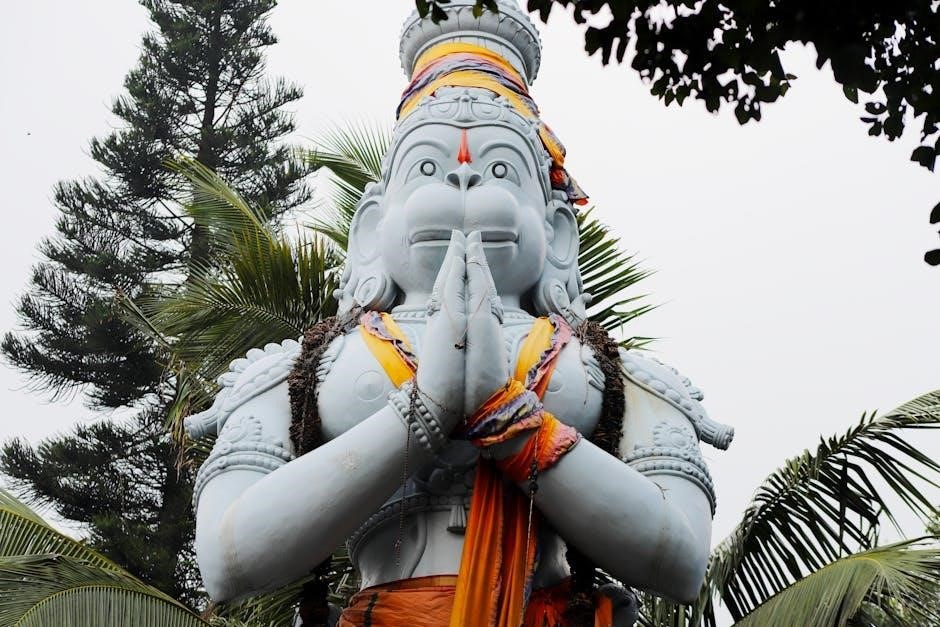
How to Recite Hanuman Vadvanal Stotra
To recite the Hanuman Vadvanal Stotra, one should ideally chant it in the early morning or evening, in a clean and peaceful environment. The stotra is typically recited 108 times over 41 days, following specific rituals and maintaining brahmacharya for optimal spiritual benefits.
3.1. Ideal Conditions for Recitation
The Hanuman Vadvanal Stotra should be recited in a clean, serene, and sacred environment, ideally during the early morning or evening hours; Devotees are advised to maintain brahmacharya and adhere to strict rituals to maximize its spiritual efficacy. It is recommended to sit facing east while reciting the stotra, ensuring a focused and pure state of mind. Chanting the stotra 108 times over 41 days, as prescribed, is believed to yield profound spiritual and material benefits, including the fulfillment of desires and the removal of obstacles.
3.2. Number of Recitations and Rituals
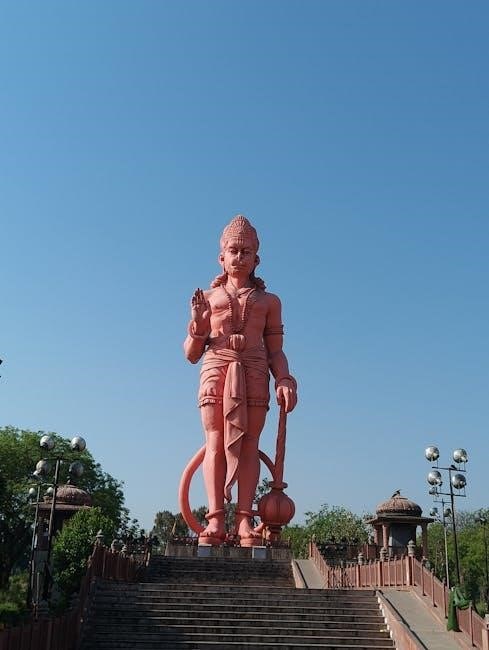
The Hanuman Vadvanal Stotra is traditionally recited 108 times over 41 days for maximum spiritual benefit. This practice, known as a “sadhana,” is believed to enhance the devotee’s connection with Hanuman and amplify the stotra’s potency. Rituals such as maintaining brahmacharya and adhering to a disciplined lifestyle are recommended to ensure the recitation’s effectiveness. Completing this cycle is said to grant profound blessings, including relief from diseases and obstacles, and fulfillment of sincere desires.

Structure and Content of the Stotra
The Hanuman Vadvanal Stotra begins with the admiration of Hanuman’s divine virtues and immense power. It then transitions into heartfelt requests for his blessings and protection, seeking relief from diseases and obstacles. The hymn’s structure emphasizes devotion, faith, and the deep connection with Hanuman, making it a powerful tool for spiritual growth and divine grace.
4.1. Praise of Hanuman’s Virtues
The Hanuman Vadvanal Stotra commences with an eloquent praise of Hanuman’s exceptional virtues, highlighting his boundless strength, unwavering courage, and unrelenting loyalty to Lord Rama. It glorifies his wisdom and selflessness, portraying him as a symbol of devotion and righteousness. The stotra vividly describes Hanuman’s divine attributes, emphasizing his role as a protector and a remover of obstacles. These praises not only extol his divine essence but also reinforce his status as a beloved deity in Hinduism, inspiring devotees to emulate his noble qualities and seek his divine grace.
4.2. Requests for Blessings and Protection
The Hanuman Vadvanal Stotra humbly seeks Lord Hanuman’s divine blessings and protection, imploring him to alleviate suffering, remove obstacles, and grant spiritual and material well-being. Devotees pray for relief from diseases, negative energies, and life’s challenges, trusting in Hanuman’s compassion and strength; The stotra also requests his guidance on the path of righteousness, emphasizing the importance of faith and devotion. By sincerely reciting this hymn, followers believe they can attain Hanuman’s grace, ensuring protection, prosperity, and fulfillment of their heartfelt desires.
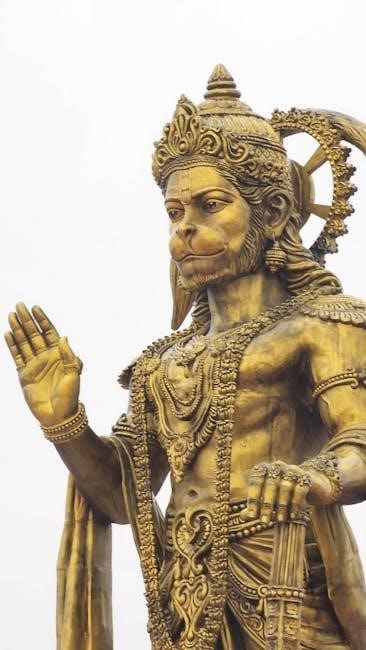
Availability in Different Languages
The Hanuman Vadvanal Stotra is available in multiple languages, including Sanskrit, Hindi, English, Tamil, Telugu, Kannada, and Gujarati, ensuring accessibility for devotees across linguistic boundaries.
5.1. Sanskrit, Hindi, and English Versions
The Hanuman Vadvanal Stotra is originally composed in Sanskrit, emphasizing its sacred and traditional roots. Hindi and English translations are widely available, making it accessible to diverse devotees. These versions maintain the stotra’s spiritual essence, ensuring its message of devotion and protection reaches a global audience. PDF formats in these languages are popular for easy download and recitation, facilitating worship and study for followers worldwide. This multilingual accessibility underscores its universal appeal and cultural significance in modern times.
5.2. Regional Language Translations
The Hanuman Vadvanal Stotra is also translated into various regional languages like Tamil, Telugu, Kannada, Gujarati, and Malayalam. These translations ensure that devotees across India can recite and connect with the stotra in their mother tongues. The regional versions maintain the spiritual essence and are widely available in PDF formats, making them easily accessible. This linguistic diversity allows followers to deepen their devotion while preserving their cultural roots, ensuring the stotra’s message resonates universally. Its availability in multiple languages has made it a beloved hymn for millions of devotees.
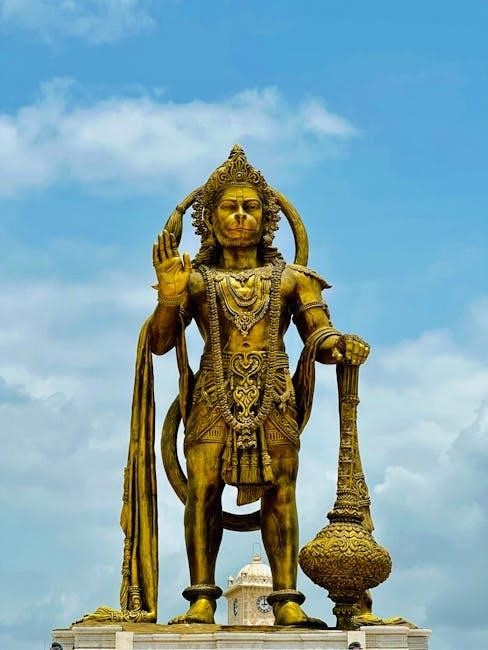
Cultural and Religious Impact
The Hanuman Vadvanal Stotra holds significant cultural and religious importance, being integral to Hindu festivals and daily worship, and is a cornerstone in devotional practices.
6.1. Role in Hindu Worship and Festivals
The Hanuman Vadvanal Stotra is deeply integrated into Hindu worship, often recited during daily puja and special festivals like Hanuman Jayanti. It is chanted in temples and homes to invoke Hanuman’s blessings, ensuring protection and prosperity. The stotra’s recitation is believed to strengthen devotees’ faith and foster a sense of community during collective worship. Its verses are also sung during processions and cultural events, making it a vibrant part of Hindu religious and cultural practices, reinforcing its significance in both spiritual and festive contexts.
6.2. Influence on Devotional Literature
The Hanuman Vadvanal Stotra has profoundly influenced Hindu devotional literature, serving as a foundational text for praising Hanuman’s divine virtues. Its verses, rich in spiritual depth, have inspired numerous compositions and hymns dedicated to the deity. The stotra’s emphasis on devotion and divine connection resonates deeply, making it a model for later literary works. Its widespread availability in multiple languages has further cemented its role in shaping devotional poetry and music, ensuring its enduring impact on Hindu spiritual and cultural traditions for generations.
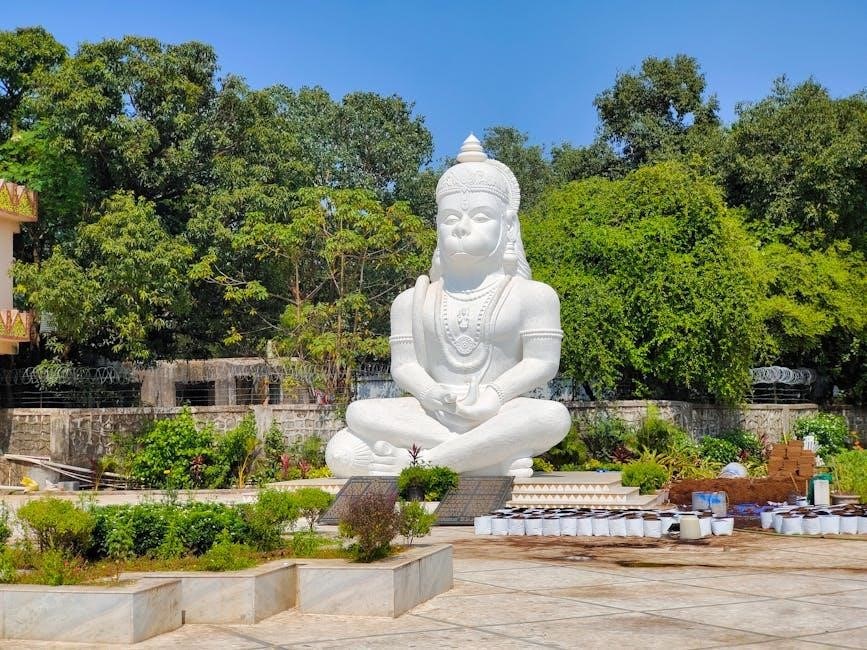
Downloading Hanuman Vadvanal Stotra PDF
The Hanuman Vadvanal Stotra PDF is readily available in multiple languages, including Sanskrit, Hindi, and English, on platforms like Scribd and other religious websites for easy access.
7.1. Reliable Sources for PDF Download
Reliable sources for downloading the Hanuman Vadvanal Stotra PDF include platforms like Scribd, religious websites, and trusted publishers. Websites such as Gur Preet and Sumit Girdharwal offer authentic versions in multiple languages. Many spiritual portals provide free downloads, ensuring easy access for devotees. These sources are verified for accuracy and quality, making them ideal for those seeking the stotra for personal or religious use. Additionally, some platforms offer translations in regional languages, catering to a diverse audience.
7.2. Formats and Languages Available
The Hanuman Vadvanal Stotra PDF is available in multiple formats, including PDF, DOCX, and TXT, ensuring accessibility for all users. It is widely offered in languages such as Sanskrit, Hindi, and English, catering to diverse linguistic preferences. Additionally, regional translations in Tamil, Telugu, Kannada, Gujarati, and other languages are available, making the stotra accessible to devotees across India. These resources are provided on various spiritual and educational platforms, ensuring ease of access for those seeking the stotra for worship or study.